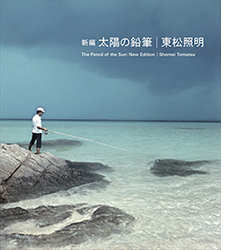
太陽の鉛筆 1975 257 × 227 mm|280 頁|写真228点収録
太陽の鉛筆 2015 257 × 227 mm|152 頁|写真103点収録
編著:伊藤俊治、今福龍太
アートディレクション : 近藤一弥
Photographs by Shomei Tomatsu
The Pencil of the Sun 1975 257×227mm|280page|228 photos
The Pencil of the Sun 2015 257×227mm|152page|103 photos
Writing & Editing : Toshiharu Ito, Ryuta Imafuku
Art Direction : Kazuya Kondo
About Book
戦後日本を代表する写真家 東松照明の最高傑作、40年を経て新たに蘇る。
東松照明は1969年に沖縄と出会って以来、1970年代前半はほぼ沖縄を中心に活動し、その成果として1975年に『太陽の鉛筆』(毎日新聞社)が刊行されました。東松が沖縄へ渡った契機の一つは、代表作「占領」シリーズの延長上に沖縄の基地の実態を撮影することにありましたが、『太陽の鉛筆』はある意味で脱占領宣言であり、脱アメリカや脱日本であり、最終的には脱国家の思考実践だったといえます。 そこには国境や領土や所有といった概念を拒もうとする精神の営みが波打ち、島々を分断させず、やがてその視線は日本という枠を超えて東南アジアへと展開しました。歴史や土地の制約からの自由を求める人間の脱領土的で群島的な想像力がイメージとして結実した『太陽の鉛筆』は、東松照明の代表作として屹立しています。
『太陽の鉛筆』の沖縄編には宮古島での7カ月の生活を綴った6つのエッセイと、宮古島や周辺の島々を撮影した150点の写真が収められています。 また東南アジア編は台湾の基隆や淡水、霧社や墾丁、フィリピンのミンダナオ島のサンボアンガ、マニラ、インドネシアのジャワ島のジャカルタ、ソロ、バリ島、マレーシアのマラッカ、タンピン、ベトナムのサイゴン、タイのランバン、チェンマイ、アユタヤ、シンガポールなど7ヶ国17地域にわたる島々が撮影され、さらに東南アジアと地続きであるかのような沖縄の渡嘉敷、那覇、普天間、コザも含めた80点の写真で構成されています。 東松はその島々の配置によって、沖縄や八重山での生活で直感した南からの流れやその系譜の向こう側へ旅しようとしたのでしょうか。
この度刊行する『新編 太陽の鉛筆』は、『太陽の鉛筆 1975』と『太陽の鉛筆 2015』の二冊組となります。『太陽の鉛筆 1975』は、既に絶版となって久しい、初版『太陽の鉛筆』を基本的な構成や順序は変えずに新たな装いで書籍化したものです。一方、『太陽の鉛筆 2015』は、基本的に『太陽の鉛筆』以後の既発表・未発表の作品のなかから103点の写真を選び、『太陽の鉛筆』に込められた南方への眼差しを引き継ぐ新たな編集意図によって配列し、二人の編者による論考を付したものです。 東松が晩年に「亜熱帯」というタイトルで構想していた熱帯植物のシリーズや、五度にわたるバリ島への旅など、移動と再-棲息化への鮮烈なヴィジョンに貫かれています。
写真については(ネガフィルムの未発見または劣化による10枚を除いて)原ネガをスキャンしたデータを調整し作成されたデジタル・プリントを原版として使用し、その陰翳と質感を晩年の東松照明の意図に沿うように刷新しました。
『新編 太陽の鉛筆』は、『1975』と『2015』の2分冊により、歴史化された作品のもつ、写真と思想の可能性を現在に呼び出す批評的な試みであり、未来への大きな問いかけを孕んで蘇るものとなっています。
The Pencil of the Sun: New Edition
Shomei Tomatsu
In 1969 photographer Shomei Tomatsu first visited Okinawa- a chain of islands which was then under American military occupation, islands which would be under US rule for another three years. Having grown up near an American base in Nagoya in the societal chaos that marked post-war Japan, Tomatsu wished to further his photographic investigation into the Americanization of his homeland by making a pilgrimage to the base of bases- Okinawa itself, the anchor of American power in the post-war Pacific. Arriving with the notion that Okinawa would naturally have to be more Americanized than other parts of Japan, Tomatsu was all the more struck by his discovery that in fact the people of Okinawa were able to survive with their own originality and intensity. This local intensity- paired with the light and color of the tropics- influenced Tomatsu's shift from black and white photography to color, a move which he later stated was an evolution away from dealing with how he saw Americanization in monochrome, and a new belief that in color, his pictures "first move toward the essence of Japan, but do not stay there. They then leap to the other side of Japan, but the landing site is unseen."
First published by Mainichi Newspapers in 1975, the original edition of The Pencil of the Sun has long been recognized as a watershed in the history of Japanese photography. Akaaka's 2015 edition is a gorgeous new presentation of this classic book that is comprised of two volumes, The Pencil of the Sun 1975 and The Pencil of the Sun 2015, enclosed in an acrylic slipcase. The first volume, 1975, is a redesigned edition of Tomatsu's iconic collection of black and white and color, images. It contains all but two pictures from the original edition- however it includes Shomei Tomatsu's original text (in Japanese) from 1975. The second volume, Pencil of the Sun 2015 is a collection of unpublished color images from Tomatsu's travels which richly extends the experience of the 1975 edition. 2015 is the product of the dedication and insight of Professor Toshiharu Ito and Anthropologist Ryuta Imafuku- both of whom provide original critical essays (in Japanese) for this second volume.
In The Pencil of The Sun: New Edition Photographs, Tomatsu's landing site can be witnessed as one that extends from Okinawa down through islands all throughout the southeast-Asian sunbelt. The result of his peregrination shows inhabited by a vibrant human authenticity in dress, action, and living on the sun-drenched islands he visited. This important body of work continues to be a significant waypoint on the understanding of both the photographic journey of one of the greatest of Japan's post-war photographers, as well as issues of culture, nationalism, and history which still resonate today.
Artist Information
東松照明|Shomei Tomatsu
1930年生。戦後日本を代表する写真家のひとり。
岩波写真文庫をへてフリーランスとして活躍。
1959年には、奈良原一高らとセルフエージェンシーVIVOを設立。
1961年に長崎を取材し、土門拳らとの共著『hiroshima-nagasaki document 1961』を刊行。
同書で第5回日本写真批評家協会作家賞を受賞。
1972年に沖縄に移住し、沖縄の島々に東南アジアでの撮影も交えた『太陽の鉛筆』 (1976年)を発表。
同書で毎日芸術賞、芸術選奨文部大臣賞を受賞。
1974年には荒木経惟、森山大道らとWORKSHOP写真学校を開校。
1992年 にメトロポリタン美術館にて、1996年には東京国立近代美術館フィルムセンターにて個展開催。
1999年に東京都写真美術館にて回顧展「日本クロニクル」開催。
2000年に「長崎マンダラ」展(長崎県立美術博物館)を開催以降、「沖縄マンダラ展」(浦添市立美術館)、
「京まんだら展」(京都国立近代美 術館)、「愛知曼荼羅展」(愛知県美術館)、
「東京曼荼羅展」(東京都写真美術館)と、日本曼荼羅シリーズを各地で開催した。
また、2004年より 2007年にかけて回顧展「Skin of the Nation」が、アメリカ、ヨーロッパ各地を巡回。
2012年没。
伊藤俊治|Toshiharu Ito
美術評論家、写真評論家、美術史家。東京芸術大学美術学部先端芸術表現科教授。
秋田県生まれ。東京大学文学部美術史学科卒業。西洋美術史を専攻。
多摩美術大学教授を経て、東京芸術大学美術学部先端芸術表現科教授。
翻訳を含め、特に内外の写真史においても著書を多数刊行している。1985年のつくば写真美術館'85の企画にも参加。
1987年に著書『ジオラマ論』により、サントリー学芸賞を受賞している。
今福龍太|Ryuta Imafuku
文化人類学者・批評家。東京外国語大学大学院教授。
東京都生まれ。栄光学園高等学校、東京大学法学部卒業。
1982年より、メキシコ・キューバ・ブラジルにて人類学的調査に従事。
87年、テキサス大学オースティン校大学院博士課程単位取得(人類学・ラテンアメリカ研究)。
エル・コレヒオ・デ・メヒコ、中部大学、慶應義塾大学SFC、カリフォルニア大学サンタクルーズ校等で
勤務・研究ののち1998年に札幌大学教授、2005年から東京外国語大学大学院教授。
2000年にはサンパウロ大学日本文化研究所客員教授を務め、現在はサンパウロ・カトリック大学客員教授として
同大学コミュニケーション・記号学研究科大学院にて随時セミナーを持つ。
山口昌男の影響のもと、いちはやく狭義の文化人類学から周辺諸領域へと越境し、従来の学問の枠に収まらない
自在な筆およびフィールドワークで独自の世界を構築する学者である。







